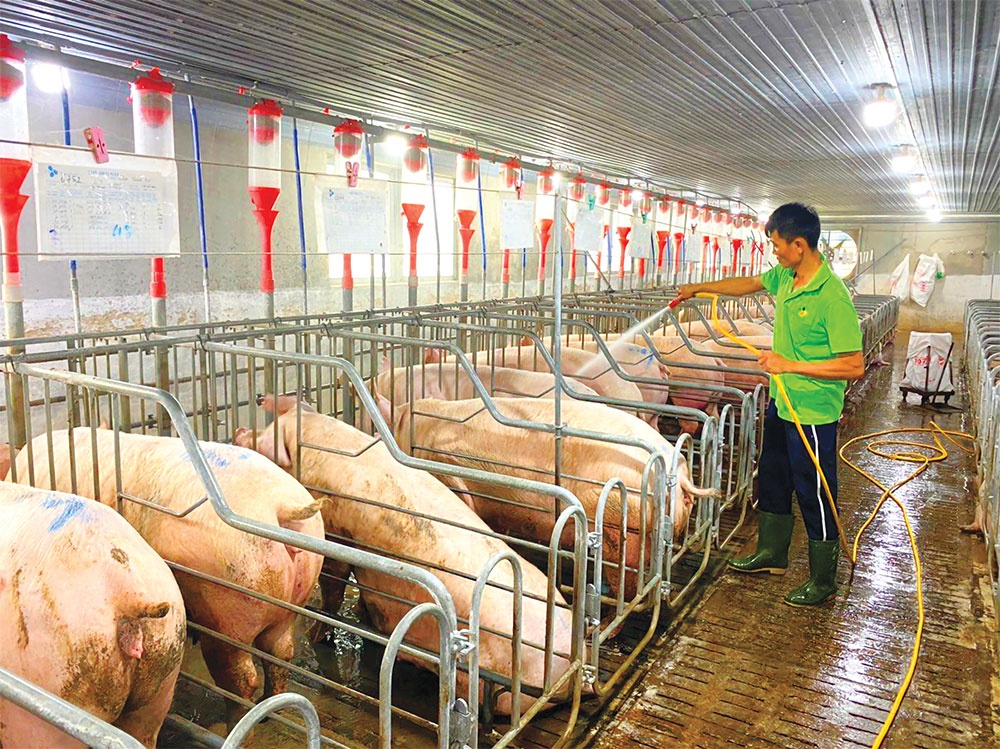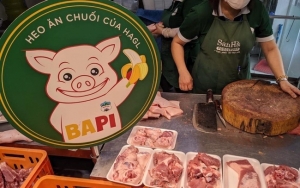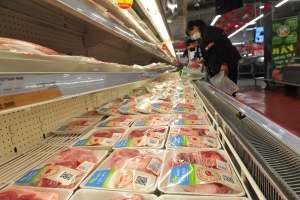Pig-breeding restructuring underway in Vietnam
 |
| Pig-breeding restructuring underway in Vietnam |
A fortnight ago, the price of live hogs saw a rise to about $2.75 per kilogramme, an increase of over 20 per cent compared to two months ago, according to the Mercantile Exchange of Vietnam. A price higher than $2.70 is said to be the level at which livestock businesses and farmers start to make profits.
“At the current selling price, we can gain a little profit after more than a year of losses,” said Nguyen Cong Thanh, a farmer in the northern province of Phu Tho.
Larger enterprises that can breed at lower costs are projected to recover more quickly. However, for the past year or so, most local husbandry companies have reported negative business results, and major players like Dabaco have struggled with big losses.
According to its financial statement for the first quarter in 2023, Dabaco Group reported $96.4 million in revenues, down 17.5 per cent on-year, and lost $13.4 million in after-tax profit. Selling prices of the company’s pigs were lower than the cost, so gross profit was reported at -$3 million.
Meanwhile, BAF Vietnam Agriculture reported $34 million in revenue, down 46.9 per cent on-year, and $163,000 in after-tax profit, down 95.5 per cent on-year. Of this, the gross profit margin decreased from 9.2 to 7.8 per cent.
However, in 2022 GreenFeed Vietnam still reported significant profits - despite some decline on-year. The company reported an after-tax profit of nearly VND417 billion ($17.4 million) in the year, down 32 per cent on-year. Total assets at the end of the year reached $406 million, up nearly 16 per cent compared to the beginning of the year.
“The domestic consumer food market in the first quarter of 2023 saw many fluctuations due to changes in consumer demand and purchasing power,” a representative of GreenFeed told VIR.
“We are boosting research and introducing new products to meet diverse consumer needs and become a priority of GreenFeed food sector like ready-cut fresh meat, ready-meal products, spices, and B2B distribution channels.”
Economic recovery along with lower input prices may support the market in the long term. The Organisation for Economic Co-operation and Development forecast that pork consumption in Vietnam will record an annual growth of about 3.1 per cent in by the end of 2023, while consulting firm Fitch Solutions also said Vietnam’s pork consumption is increasing by 25 per cent between 2018 and 2026.
Based on inflation dipping since March, the domestic demand is likely to have markedly improved, which is expected to help hog prices continue rising in the second half of this year. Besides that, the cooling of agricultural product prices since the beginning of the year will also support the industry, especially when about three-quarters of the country’s feed material supply depends on import resources.
According to preliminary data from the General Department of Vietnam Customs, the country imported over 398,600 tonnes of corn in May, down 36 per cent on-month. The cumulative import of corn in the first five months of this year was also 9.6 per cent lower than the same period last year, and major markets were from Brazil (accounting for 43 per cent of the total corn import of the country), and Argentina (making up 28.3 per cent).
BAF chairman Truong Sy Ba said that the pig breeding sector is in a period of restructuring.
“The market share of small livestock farms is gradually belonging to big companies. If small households had accounted for 70 per cent of livestock market share before 2019, this number has decreased sharply after the African swine fever epidemic. The number of farm households in Vietnam has decreased nearly five-fold to less than two million households in the last 10 years,” Ba said.
He cited, especially in the southern province of Dong Nai, that the market share of small-scale farms is only about 25-30 per cent, a sharp decrease compared to 70 per cent over the last 5-10 years. “BAF and other players are receiving this wave, taking market share from smallholder farmers,” Ba added.
At present, the total herd of BAF is about 230,000 pigs. It is continuing to add to its modern farms, and expects to put into operation nine more by the end of 2024. The company self-produces animal feed and utilises waste bananas, and so production costs are cheaper than other firms.
 | Pig farm fuss highlights foul plight A big pig farm in the northern province of Ninh Binh is in the centre of a serious pollution scandal, with the owner refusing responsibility and the local authorities woefully lacking oversight to set matters straight. |
 | Japfa inaugurates pig farm with 10,000 sows in Binh Phuoc province Early this week, Japfa Comfeed Vietnam Co., Ltd. (Japfa Vietnam) inaugurated and put into operation a pig farm with 10,000 sows in Dak Nhau commune, Bu Dang district, Binh Phuoc province in Vietnam’s south eastern region. |
 | Suspicion over Hoang Anh Gia Lai Group's long-term growth trajectory Since exiting the real estate segment in 2012, privately-held Hoang Anh Gia Lai Group (HAGL) has continually been pivoting to the agriculture business. However, the business efficiency of the fresh approach remains vague. |
 | MM Mega Market launches initiative to collaborate with pig farmers MM Mega Market's private label brand, We Are Fresh, has launched an initiative to collaborate with pig farmers and promote fresh, high-quality meat products at stable prices. |
What the stars mean:
★ Poor ★ ★ Promising ★★★ Good ★★★★ Very good ★★★★★ Exceptional
Related Contents
Latest News
More News
- First members of Danang International Finance Centre revealed (December 22, 2025 | 17:39)
- Human-centred governance seen as key to AI development (December 19, 2025 | 18:19)
- Top 10 notable events of Vietnam’s industry and trade sector in 2025 (December 19, 2025 | 14:00)
- Tungsten surges to 12-year high as world enters a new 'black gold' race (December 18, 2025 | 17:27)
- Vietnam’s coffee exports set new record despite price pressures (December 18, 2025 | 17:13)
- Garment and textile sector seeks new growth after volatile year (December 18, 2025 | 17:01)
- VinSpeed and Siemens strengthen cooperation for high-speed rail development (December 18, 2025 | 16:53)
- High-tech adoption for TH true MILK (December 18, 2025 | 13:39)
- Takeda supports health resilience amid climate change challenges (December 18, 2025 | 12:39)
- Mondelez Kinh Do - a chapter of purpose-led leadership in Vietnam (December 18, 2025 | 09:44)

 Tag:
Tag:






















 Mobile Version
Mobile Version